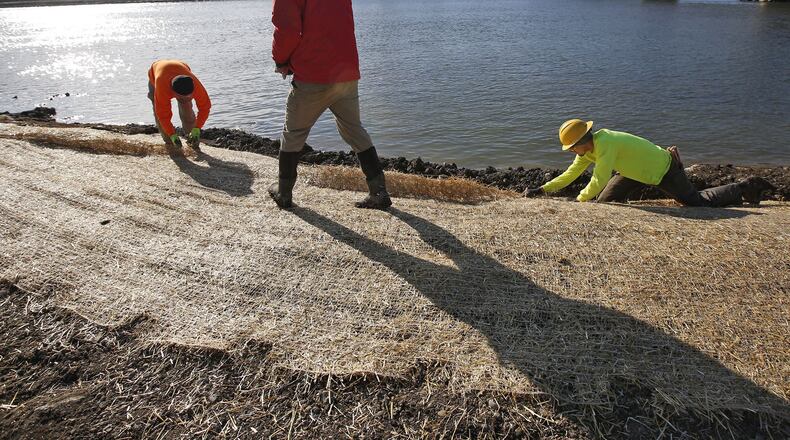The $1.75 million removal of the Tait Station low dam between Dryden Road and Interstate 75, which began in July, wrapped upWednesday, according to the Miami Conservancy District. The project was funded by the Ohio Department of Transportation.
MORE: City buys riverfront land for new ‘entertainment district’
Removal of the low dam will both improve water quality and make the river safer to enjoy, Hippensteel Hall said.
“Removing that dam eliminated a real threat to people trying to paddle or fish near the dam. That threat is no longer there because the dam created a place that could drown people,” she said.
There was more to the project than removing the 600-foot dam, said Hippensteel Hall. Riverbanks were reshaped and the channel rebuilt with a new rock structure called a riffle to enhance aquatic life, which when abundant signals a healthy river.
The Great Miami River carries not only water but is a driver of recreation, tourism and economic development for 16 communities up and down the 99-mile corridor extending from Sidney to Hamilton, said Elizabeth Connor, Great Miami Riverway coordinator.
MORE: Partners put up $1 million to promote river’s value for 16 local cities
Riverway communities had a tourism impact of $773 million that sustained 9,110 jobs in 2017, Connor told Montgomery County commissioners last month, citing a Tourism Economics study. The report also showed $16 million in direct riverfront investment during last year.
Promoting the river and trail system as amenities helps companies and communities attract and retain a skilled workforce, Connor said.
“What we’ve heard back from venture capitalists, from entrepreneurs, from CEOs looking to hire some top-level talent, access to first-class outdoor recreation is extremely important,” she said.
Connor said about 150 new signs and kiosks went up this year in partnerships with communities and the Greater Dayton Regional Transit Authority to ease wayfinding and promote sites along the riverway’s trails.
The Tait Station low dam was originally constructed to provide cooling water for the power plant built around 1935 by Dayton Power and Light. The plant was decommissioned in 1983, and ownership of the low dam transferred to MCD in 1990. Never used for flood control, the deteriorating 600-foot-long dam, which no longer served any purpose, would have required $5 to $8 million in repairs, according to MCD.
MORE: Bridges have been at this local spot about 180 years. A new $21M one is coming.
A 2015 US Army Corps of Engineers report about the Great Miami River Corridor recommended removing the Tait Station low dam. Both the city of Dayton and Montgomery County passed resolutions supporting the project.
Another low dam at Monument Avenue in downtown was partially removed beginning in Sept. 2016 and transformed into one of the features of the $4 million RiverScape River Run, a kayak play area with boating passages that opened in May 2017.
MORE: River Run opening pushes more change in heart of Dayton
Of the two dams nearest the Tait Station dam on the Great Miami River, one is upstream just below Island MetroPark, and one is downstream spanning the river between West Carrollton and the Moraine Airpark, which both allow communities to use deeper pools recreationally for boating and rowing.
The more people use the river and come to enjoy it as a natural resource, the more willing they will be to help preserve it, Hippensteel Hall said.
“Getting people to love the river makes it more likely they will take steps to care for the river,” she said. “And improving safety and increasing access hopefully helps more people get down to the river to love it.”
About the Author

